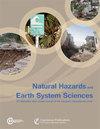Simulating sea level extremes from synthetic low-pressure systems
IF 4.2
2区 地球科学
Q1 GEOSCIENCES, MULTIDISCIPLINARY
引用次数: 0
Abstract
Abstract. In this article we present a method for numerical simulations of extreme sea levels using synthetic low-pressure systems as atmospheric forcing. Our simulations can be considered to be estimates of the high sea levels that may be reached when a low-pressure system of high intensity and optimal track passes the studied region. We test the method using sites located along the Baltic Sea coast and simulate synthetic cyclones with various tracks. To model the effects of the cyclone properties on sea level, we simulate internal Baltic Sea water level variations with a numerical two-dimensional hydrodynamic model, forced by an ensemble of time-dependent wind and air-pressure fields from synthetic cyclones. The storm surges caused by the synthetic cyclones come on top of the mean water level of the Baltic Sea, for which we used a fixed upper estimate of 100 cm. We find high extremes in the northern Bothnian Bay and in the eastern Gulf of Finland, where the sea level extreme due to the synthetic cyclone reaches up to 3.5 m. In the event that the mean water level of the Baltic Sea has a maximal value (1 m) during the cyclone, the highest sea levels of 4.5 m could thus be reached. We find our method to be suitable for use in further studies of sea level extremes.通过合成低压系统模拟海平面极端变化
摘要在这篇文章中,我们介绍了一种利用合成低压系统作为大气强迫的极端海平面数值模拟方法。我们的模拟可视为对高强度和最佳路径的低压系统经过研究区域时可能达到的高海平面的估计。我们使用位于波罗的海沿岸的站点对该方法进行了测试,并模拟了具有不同路径的合成气旋。为了模拟气旋特性对海平面的影响,我们使用二维流体力学数值模型模拟了波罗的海内部的水位变化,该模型由合成气旋产生的随时间变化的风场和气压场组成。合成气旋引起的风暴潮位于波罗的海平均水位之上,我们将平均水位的上限固定为 100 厘米。我们发现,北部波的尼亚湾和东部芬兰湾的极端海平面较高,合成气旋造成的极端海平面高达 3.5 米。如果气旋期间波罗的海的平均水位达到最大值(1 米),则最高海平面可达 4.5 米。我们认为我们的方法适合用于进一步的极端海平面研究。
本文章由计算机程序翻译,如有差异,请以英文原文为准。
求助全文
约1分钟内获得全文
求助全文
来源期刊
CiteScore
7.60
自引率
6.50%
发文量
192
审稿时长
3.8 months
期刊介绍:
Natural Hazards and Earth System Sciences (NHESS) is an interdisciplinary and international journal dedicated to the public discussion and open-access publication of high-quality studies and original research on natural hazards and their consequences. Embracing a holistic Earth system science approach, NHESS serves a wide and diverse community of research scientists, practitioners, and decision makers concerned with detection of natural hazards, monitoring and modelling, vulnerability and risk assessment, and the design and implementation of mitigation and adaptation strategies, including economical, societal, and educational aspects.

 求助内容:
求助内容: 应助结果提醒方式:
应助结果提醒方式:


